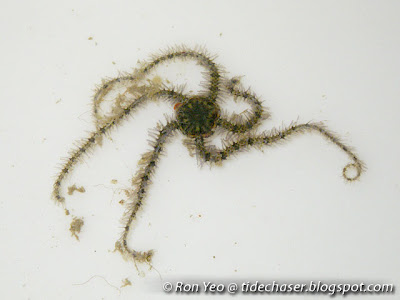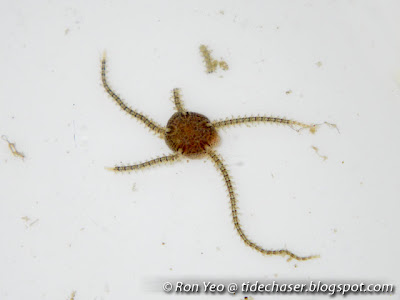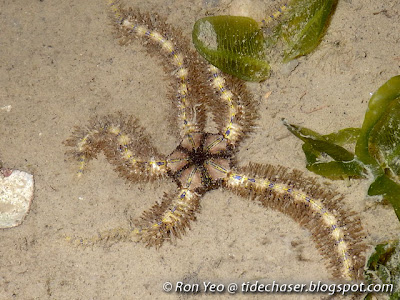Brittle stars (class Ophiuroidea) are marine animals typically with five thin, segmented arms extending from a central disc. "Ophiuroidea" means "snake-like", refering to the animals' long and flexible arms, and hence they are also often called serpent stars.

When disturbed, brittle stars cast off parts of their arms (thus the common name "brittle star"), not unlike a lizard's tail, to distract any possible predator. Like other members of the phylum Echnodermata, they are able to regenerate the lost arms.

The echinoderms are often called the spiny-skinned animals (phylum Echinodermata - "echino" roughly means "spiny"; "derma" roughly means "skin"). Examples of other echinoderms include sea stars, sea cucumbers, and sea urchins. Like other echinoderms, brittle stars have a five-part body plan with radial symmetry (i.e. pentaradial symmetry), at least in some stage of life. In other words, you can divide a brittle star into 5 equal parts.
Echinoderms are brainless, but despite that, they can still perform their daily functions - they can move, they can eat, they can shit, and they can reproduce - all these without a brain! Also, instead of blood vessels, echinoderms have a water vascular system. This system is essentially a network of water-filled vessels used for internal transportation of oxygen, food and waste. By adjusting the water pressure, the brittle star is able extend and retract its arms to move and feed.

Brittle stars mostly forage at night, and hide in crevices or under rocks in the day. Some lives commensally with other organisms - it is believed that living with other animals may give them better access to food and shelter, but their presence does not affect the host animal.

Brittle stars have a mouth on the underside but no anus. They mostly feed on tiny organic particles (detritus) collected with their tube feet on the underside of their arms, though some species may feed on smaller animals.

Some species burrow into the sand in the day, emerging only at night. More than 30 species of brittle stars have been seen in Singapore.
Order Phrynophiurida
Members of this order are usually called basket stars. They are a special group of brittle stars with arms branching into smaller arms, forming a network branches. The arms are usually spread out like a basket to catch plankton in the water column.

Several basket stars (suborder Euryalina) also live with sea fans, such as this tiny unidentified species about 2cm wide found during a dredging trip.

Bigger basket stars, such as this unidentified species, will either cling to the substrate or other organisms to catch its food.

The above is another basket star found on a sea fan in the intertidal area.
Order Ophiurida
Most of the brittle stars are from this order. They are characterised by unbranched arms and scales covering the upper side of the disc.
Family Ophiactidae
Brittle stars from this family generally have discs covered with spines and granules, thought they usually do not conceal the scales. They have short, erect spines. They are distinguished by a rectangular, block-like oral papilla (protruding structure at the mouth) at the tip of each jaw.

Some brittle stars form this family, such as the Ophiactis species above, live in sponges or other animals.

Ophiactis savignyi, for example, has been found living with sponges, feather stars and sea stars. Sometimes they can also be found living on their own, either hiding under rocks and or in crevices. They are small, about 1-2cm wide including the arms, and green in colour.
Family Ophiotrichidae
Brittle stars from this family have well-developed scales. Their arms are flexible in all directions, and come with delicate translucent, thorny spines. They lack oral papillae, but instead have papillae on their teeth.

Ophiomaza cacaotica from this family can be found living on feather stars. It has distinctive black (or dark purple) and white patterns on the disc, and the arms has a pair of black lines running down the sides. This specimen which I saw was about 10cm wide, including the arms.

The colour and patterns of Ophiomaza cacaotica may vary. The above is a specimen that is mostly white.

The above Ophiomaza cacaotica is mostly black instead.

Ophiothela species are usually also commensals, and have also been seen on sea pens, soft corals and sea fans. These small commensals are less than 1cm across, and come with colourful bands on their arms.

This Ophiothela danae lives on sea fans, clinging tightly to the branches.

The above is a closer look at the Ophiothela danae on a sea fan.

The Jellyfish Brittle Stars (Ophiocnemis marmorata) is sometimes seen on large jellyfish stranded on our shores.

Here is a closer look at the Jellyfish Brittle Star. This brittle star are commensals on large jellyfish. The exact relationship is not known, though scientists suspect that they live on jellyfish for protection and also for food - they feed on the leftover food of their hosts. It was also suggested that only the small ones live on jellyfish, while the bigger ones would eventually drop off and hence get dispersed.

Ophiothrix plana is seen once at Semakau. It is dark green in colour, with long translucent spines on the arms.

Ophiothrix lineocaerulea emerges from its hiding place and forages in the seagrass meadows at night. It has a characteristic colour pattern of two dark parallel lines along the top side of each arm. Bluish bands can be seen on the arms as well.

Ophiothrix melanosticta has pretty red spots on its arms. It has dense bottlebrush-like spines on its arms. It has been seen on soft corals sometimes.

The closely related Macrophiothrix longipeda is more often found on reef flats. It is usually grey with thin black bands running down the arms. A pair of thin parallel black lines run along the top sides of the arms.
Family Amphiuridae
Brittle stars from this family are usually small and fragile. The jaws come with a pair of papillae at the tip, and one or more on each side.

The small Amphipholis squamata is usually greyish or bluish white in colour, and about 2cm wide. It is usually found under rocks and shells.
Family Ophiodermatidae
Brittle stars of this family have arms projecting from, and well fused to, the edge of the disc. The main disc is usually covered in dense coating of granules, and the arm spines are short and hardly noticeable without a microscope.

This Ophiodyscrita acosmeta has dark brown bands running along its arms on a pale brown background.
Many of our brittle star species are not yet identified, and like most other marine organisms, the ophiuroids in Singapore are threatened by loss of habitats and collection. Here are a few of the brittle stars which I could not identify.

This tiny brittle star is about 1cm wide, and lives on a sea apple.

This unidentified brittle star has bright yellow bands on its arms. It was found among seagrasses growing on a sandy substrate.

This unidentified brittle star with bluish bands on its arms was found among seagrasses on a sandy-muddy substrate.
References

When disturbed, brittle stars cast off parts of their arms (thus the common name "brittle star"), not unlike a lizard's tail, to distract any possible predator. Like other members of the phylum Echnodermata, they are able to regenerate the lost arms.

The echinoderms are often called the spiny-skinned animals (phylum Echinodermata - "echino" roughly means "spiny"; "derma" roughly means "skin"). Examples of other echinoderms include sea stars, sea cucumbers, and sea urchins. Like other echinoderms, brittle stars have a five-part body plan with radial symmetry (i.e. pentaradial symmetry), at least in some stage of life. In other words, you can divide a brittle star into 5 equal parts.
Echinoderms are brainless, but despite that, they can still perform their daily functions - they can move, they can eat, they can shit, and they can reproduce - all these without a brain! Also, instead of blood vessels, echinoderms have a water vascular system. This system is essentially a network of water-filled vessels used for internal transportation of oxygen, food and waste. By adjusting the water pressure, the brittle star is able extend and retract its arms to move and feed.

Brittle stars mostly forage at night, and hide in crevices or under rocks in the day. Some lives commensally with other organisms - it is believed that living with other animals may give them better access to food and shelter, but their presence does not affect the host animal.

Brittle stars have a mouth on the underside but no anus. They mostly feed on tiny organic particles (detritus) collected with their tube feet on the underside of their arms, though some species may feed on smaller animals.

Some species burrow into the sand in the day, emerging only at night. More than 30 species of brittle stars have been seen in Singapore.
Order Phrynophiurida
Members of this order are usually called basket stars. They are a special group of brittle stars with arms branching into smaller arms, forming a network branches. The arms are usually spread out like a basket to catch plankton in the water column.

Several basket stars (suborder Euryalina) also live with sea fans, such as this tiny unidentified species about 2cm wide found during a dredging trip.

Bigger basket stars, such as this unidentified species, will either cling to the substrate or other organisms to catch its food.

The above is another basket star found on a sea fan in the intertidal area.
Order Ophiurida
Most of the brittle stars are from this order. They are characterised by unbranched arms and scales covering the upper side of the disc.
Family Ophiactidae
Brittle stars from this family generally have discs covered with spines and granules, thought they usually do not conceal the scales. They have short, erect spines. They are distinguished by a rectangular, block-like oral papilla (protruding structure at the mouth) at the tip of each jaw.

Some brittle stars form this family, such as the Ophiactis species above, live in sponges or other animals.

Ophiactis savignyi, for example, has been found living with sponges, feather stars and sea stars. Sometimes they can also be found living on their own, either hiding under rocks and or in crevices. They are small, about 1-2cm wide including the arms, and green in colour.
Family Ophiotrichidae
Brittle stars from this family have well-developed scales. Their arms are flexible in all directions, and come with delicate translucent, thorny spines. They lack oral papillae, but instead have papillae on their teeth.

Ophiomaza cacaotica from this family can be found living on feather stars. It has distinctive black (or dark purple) and white patterns on the disc, and the arms has a pair of black lines running down the sides. This specimen which I saw was about 10cm wide, including the arms.

The colour and patterns of Ophiomaza cacaotica may vary. The above is a specimen that is mostly white.

The above Ophiomaza cacaotica is mostly black instead.

Ophiothela species are usually also commensals, and have also been seen on sea pens, soft corals and sea fans. These small commensals are less than 1cm across, and come with colourful bands on their arms.

This Ophiothela danae lives on sea fans, clinging tightly to the branches.

The above is a closer look at the Ophiothela danae on a sea fan.

The Jellyfish Brittle Stars (Ophiocnemis marmorata) is sometimes seen on large jellyfish stranded on our shores.

Here is a closer look at the Jellyfish Brittle Star. This brittle star are commensals on large jellyfish. The exact relationship is not known, though scientists suspect that they live on jellyfish for protection and also for food - they feed on the leftover food of their hosts. It was also suggested that only the small ones live on jellyfish, while the bigger ones would eventually drop off and hence get dispersed.

Ophiothrix plana is seen once at Semakau. It is dark green in colour, with long translucent spines on the arms.

Ophiothrix lineocaerulea emerges from its hiding place and forages in the seagrass meadows at night. It has a characteristic colour pattern of two dark parallel lines along the top side of each arm. Bluish bands can be seen on the arms as well.

Ophiothrix melanosticta has pretty red spots on its arms. It has dense bottlebrush-like spines on its arms. It has been seen on soft corals sometimes.

The closely related Macrophiothrix longipeda is more often found on reef flats. It is usually grey with thin black bands running down the arms. A pair of thin parallel black lines run along the top sides of the arms.
Family Amphiuridae
Brittle stars from this family are usually small and fragile. The jaws come with a pair of papillae at the tip, and one or more on each side.

The small Amphipholis squamata is usually greyish or bluish white in colour, and about 2cm wide. It is usually found under rocks and shells.
Family Ophiodermatidae
Brittle stars of this family have arms projecting from, and well fused to, the edge of the disc. The main disc is usually covered in dense coating of granules, and the arm spines are short and hardly noticeable without a microscope.

This Ophiodyscrita acosmeta has dark brown bands running along its arms on a pale brown background.
Many of our brittle star species are not yet identified, and like most other marine organisms, the ophiuroids in Singapore are threatened by loss of habitats and collection. Here are a few of the brittle stars which I could not identify.

This tiny brittle star is about 1cm wide, and lives on a sea apple.

This unidentified brittle star has bright yellow bands on its arms. It was found among seagrasses growing on a sandy substrate.

This unidentified brittle star with bluish bands on its arms was found among seagrasses on a sandy-muddy substrate.
References
- Castro, P & M. E. Huber, 2003. Marine biology. McGraw-Hill, US.
- Coleman, N., 2007. Sea stars: echinoderms of Asia/Indo-Pacific. Neville Coleman’s Underwater Geographic Pty Ltd, Australia.
- Davison, G.W. H., P. K. L. Ng & H. C. Ho, 2008. The Singapore red data book: threatened plants and animals of Singapore. Nature Society (Singapore).
- ETI BioInformatics. 2012. Marine species identification portal. Retrieved Oct 3, 2012, from http://species-identification.org.
- Lane, D. J.W. & D. Vandenspiegel, 2003. A Guide to sea stars and other echinoderms of Singapore. Singapore Science Centre.
- Lane, D.J.W., L.M. Marsh, D.VandenSpiegel, & F.W.E. Rowe. 2000. Echinoderm fauna of the South China Sea: an inventory and analysis of distribution patterns. The Raffles Bulletin of Zoology, Suppl.8: 459-493.
- Liao, Y. & A. M. Clark, 1995. The Echinoderms of Southern China. Science Press, China.
- World Register of Marine Species. 2012. Retrieved Oct 3, 2012, from http://www.marinespecies.org.

No comments:
Post a Comment